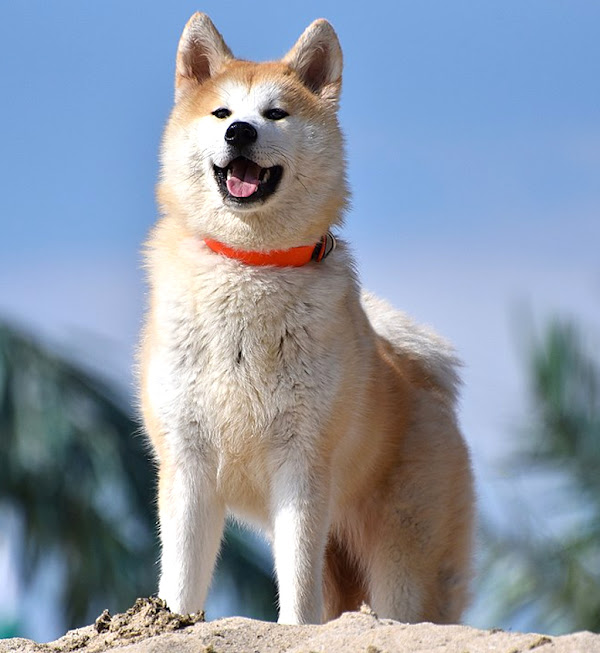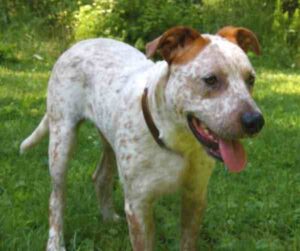The Akita dog is a very beautiful and large breed of dog. It is a powerful, independent and dominant breed, commonly aloof with strangers but affectionate with family members. It is also known by some other names such as Akita Inu, Japanese Akita and Great Japanese Dog.
The Akita dogs were originated from northern Japan. They were developed from native Japanese dogs from the Akita prefecture of northern Japan and go back up to 1000 years. The breed was involved in dog fighting in the 1600s, which at the time was popular in Japan.
Total number of the Akita puppies was in decline during the early 20 Century, as a result of being cross bred with the German Shepherd dog. As a result, a lot of specimens started to lose their spitz characteristics and instead took on drop ears, straight tails, non-Japanese color (black masks, and any color other than red, white or brindle), and loose skin.
A native Japanese breed known as Matagi (hunting dog) was used along with the Hokkaido Inu breed to mix back into the remaining Akita Inu to bring back the spitz phenotype and restore the Akita breed. And the modern day Japanese Akita have relatively few genes from western dogs and are spitz in phenotype after the reconstruction of the breed took place.
The Akita was also crossed with German Shepherds during the Second World War in an attempt to save them from the wartime government order for all non-military dogs to be culled. The ancestors of the American Akita were originally a variety of the Japanese Akita, a form that was not desired in Japan due to the markings, and which is not eligible for show competition.
There are two separate varieties of Akita. The Japanese strain and the American strain. The Japanese strain is commonly called Akita Inu (inu means dog in Japanese), or Japanese Akita. And the American strain is known as simply Akita or American Akita.
The Japanese strain comes in a narrow palette or colors with all other colors considered atypical of the breed. While the American strain comes in all dog colors. The Japanese and American strains of Akita are considered two separate breeds, in all countries except United States. The two strains are considered a single breed with differences in type in the United States.[1]
Akita Dog Characteristics
The Akita dogs are large and beautiful animals. Their main physical characteristics include a large, bear-like head with erect, triangular ears set at a slight angle following the arch of the neck. Their eyes are small, dark, deeply set and triangular in shape.
The Akita puppies have thick double coats, and tight, well knuckled cat-like feet. Their tails are carried over the top of the back in a gentle or double curl down the loin.
According to the breed standards, all dog breed coat colors are allowable in the American Akita (including pinto, solid white, black mask, all types of brindle, white mask, self-colored mask, even differing colors of udder coat and guard hairs).
The Japanese Akitas, as per the breed standards, are restricted to red, fawn, sesame, brindle, pure white, all with Urajiro markings whitish coat on the sides of the muzzle, on the cheeks, on the underside of jaw, neck, chest, body and tail and on the inside of the legs.

The mature American type females generally measure 24 to 26 inches at the withers, and weigh between 32 and 45 kg. While the males measure generally between 26 and 28 inches at the withers, and weight between 45 and 59 kg. But the Japanese type are a little smaller and lighter, as stated in the breed standards.
Temperament
The Akita dog is generally seen as territorial about it’s property, and can be reserved with strangers. It is sometimes described as feline in its actions; it is not unusual for an Akita to clean its face after eating, to preen its kennel mate, and to be fastidious in the house.
As per the AKC standard, the Akita dogs are known to be intolerant of other dogs of the same gender. And they are not considered as a good breed for the first time dog owner, as they are large and powerful dogs. They have been targeted by some country’s breed-specific legislation as a dangerous dog.
The Akitas are large, strong, independent and dominant dog. A well trained Akita dog should be accepting of non-threatening strangers, otherwise they will treat all strangers in an aggressive manner.
It is said that the Akita breed has an affinity for children. So as a breed they should be good with children. But not all Akitas will necessarily have the same temperament.
Akitas tend to take a socially dominant role with other dogs, and thus caution must be used in situations when Akitas are likely to be around other dogs, especially unfamiliar ones. In particular, they tend to be less tolerant of dogs of the same gender.
For this reason, Akitas, unless highly socialized, are not generally well-suited for off-leash dog parks. Sometimes spontaneous, it needs a confident, consistent handler, without which the dog will be very wilful and may become very aggressive to other dogs and animals.
Lifespan
Average lifespan of the Akita dog is between 10 and 13 years.
Feeding
How much a mature dog eats depends on it’s size, age, build, metabolism and activity level. Dogs are individuals, just like people, and they don’t all need the same amount of food. 3 to 5 cups of high quality dry food a day is recommended for a mature dog. You can consult with your vet for better recommendation.
Caring
The Akita dog is happiest and does it’s best when living inside with their family. They do need daily exercise. About 30 minutes to an hour of waking a day is sufficient for an Akita puppy. Visits to a dog park are probably not a good idea, given the Akita’s aggressive tendency toward other dogs.
As the Akita dogs are highly intelligent, so a varied routine for them will work best. Don’t leave them alone for long periods at a time. Because, that leads to such behavior problems as barking, digging, chewing and aggression.
A securely fenced yard is important too, both for the safety of the Akita and for the safety of strangers who may mistakenly come into their turf. While they aren’t typically aggressive with visitors if their family is home, all bets are off if their owners aren’t around. The Akita is a loyal guardian, and they’ll protect against anything they perceive to be a threat.
Take especial care, especially when raising an Akita puppy. The Akitas grow very rapidly between the age of 4 and 7 months, making them susceptible to bone disorders. They do well on a high-quality, low-calorie diet that keeps them from growing too fast. In addition, don’t let your Akita puppy run and play on hard surfaces, such as pavement; normal play on grass is fine.
Avoid forced jumping or jogging on hard surfaces until the dog is at least two years of old, and their joints are fully formed. As the Akitas are one of the most dominant dog breeds, so training should start in an early age of 7 to 8 weeks.
Health
Akitas are generally healthy, but like all breeds of dogs, they’re prone to certain conditions and diseases. The Akita is a powerful, independent and dominant breed, commonly aloof with strangers but affectionate with family members. As a breed, Akitas are generally hardy, but they have been known to be susceptible to various genetic conditions and can be sensitive to certain drugs.
So, it is important to maintain a good care and regular vet checkups. Some of the more common health problems that the Akbash dog suffer from are hip dysplasia, bloat, hypothyroidism, progressive retinal atrophy and sebaceous adenitis. Always keep good contact with a vet in your area.
| Breed Name | Akita |
| Other Names | Akita Inu, Japanese Akita and Great Japanese Dog, American Akita |
| Breed Size | Large |
| Height | 26 to 28 inches tall at the withers for males, and 24 to 26 inches for females |
| Weight | 45 to 59 kg for males and 32 to 45 kg for females |
| Good as pets | Yes |
| Climate Tolerance | All climates |
| Color | Many |
| Lifespan | 10 to 13 years |
| Good for children | Yes |
| Rarity | Common |
| Country of Origin | Japan |






